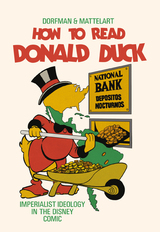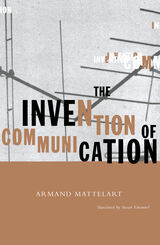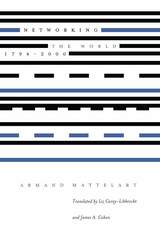3 books about Mattelart, Arm

How to Read Donald Duck
Imperialist Ideology in the Disney Comic
Ariel Dorfman
Pluto Press, 2020
"The book has a rambunctious humor that complements its polemical spirit . . . As Disney has evolved from an animation studio into a corporate behemoth—with theme parks, a cruise line, and content streaming around the world—How to Read Donald Duck and its charge of cultural imperialism rings all the truer"—The New Yorker
First published in 1971, How to Read Donald Duck shocked readers by revealing how capitalist ideology operates in our most beloved cartoons. Having survived bonfires, impounding and being dumped into the ocean by the Chilean army, this controversial book is once again back on our shelves.
Written and published during the blossoming of Salvador Allende's revolutionary socialism in Chile, the book examines how Disney products reflect capitalist ideology, and are active agents working in this ideology’s favor. Focusing on the hapless mice and ducks of Disney, curiously parentless, marginalized and always short of cash, Ariel Dorfman and Armand Mattelart expose how these characters established hegemonic ideas about capital, race, gender and the relationship between developed countries and the Third World.
A devastating indictment of a media giant, a document of twentieth-century political upheaval, and a reminder of the dark undercurrent of pop culture, How to Read Donald Duck is once again available, together with a new introduction by Ariel Dorfman in which he writes.
"It is that joy in liberation, that alegria, that spirit of resistance, that I wish to share with America, as the book that Pinochet’s soldiers could not liquidate or Disney’s lawyers stop from entering the United States finally finds its way to its new home, deep into the land that invented Donald Duck and Donald Trump. Is the same country that gave me such a warm welcome as a child, and perhaps may now equally greet with open arms this critique of oppression and it certainty that we don’t have to leave the world as it was when we first encountered it."
First published in 1971, How to Read Donald Duck shocked readers by revealing how capitalist ideology operates in our most beloved cartoons. Having survived bonfires, impounding and being dumped into the ocean by the Chilean army, this controversial book is once again back on our shelves.
Written and published during the blossoming of Salvador Allende's revolutionary socialism in Chile, the book examines how Disney products reflect capitalist ideology, and are active agents working in this ideology’s favor. Focusing on the hapless mice and ducks of Disney, curiously parentless, marginalized and always short of cash, Ariel Dorfman and Armand Mattelart expose how these characters established hegemonic ideas about capital, race, gender and the relationship between developed countries and the Third World.
A devastating indictment of a media giant, a document of twentieth-century political upheaval, and a reminder of the dark undercurrent of pop culture, How to Read Donald Duck is once again available, together with a new introduction by Ariel Dorfman in which he writes.
"It is that joy in liberation, that alegria, that spirit of resistance, that I wish to share with America, as the book that Pinochet’s soldiers could not liquidate or Disney’s lawyers stop from entering the United States finally finds its way to its new home, deep into the land that invented Donald Duck and Donald Trump. Is the same country that gave me such a warm welcome as a child, and perhaps may now equally greet with open arms this critique of oppression and it certainty that we don’t have to leave the world as it was when we first encountered it."
[more]

Invention Of Communication
Armand Mattelart
University of Minnesota Press, 1996
A fascinating tour of all of the ways we have thought about communication, now and in the past.
Today, it is the Internet. One hundred years ago, it was the telegraph. And before that? Networks of road, rail, and water. It's all "communication." The Invention of Communication invites us to explore all the multifarious meanings that have made up our age-old attempts to connect. The book offers a heady tour of the multiple usages and systems that each historic period puts forth in the name of communication.
A veritable history of the idea of the social, Armand Mattelart's genealogy maps the many means by which humans interact-from carefully cataloguing Others, to asserting power over them, to working together with them to build new forms of community. Studying a vast array of modern forms of social intercourse and control, The Invention of Communication takes up topics such as the elaboration of warfare as a logistic, the rise of professional societies of propaganda and national propagation, the history of universal expositions and world fairs, the birth of documentary film out of physiological investigations in the nineteenth century, the development of the popular press and the popular novel, and the origins of American social science.
This history runs from the circuits of exchange to the circulation of goods, people, and messages, from the construction of railroads to the emergence of long-distance communication. Throughout, Mattelart brings a clarifying perspective to the ideologies and theories that accompany these transformations. He shows how Enlightenment and nineteenthÂcentury utopian thinking about communication led to the strategic and geopolitical thinking of the twentieth century, and finally to mass and individual psychosociology, mass culture, and marketing. The Invention of Communication is a remarkable interpretation of the dizzying complex of systems supporting the social world of modernity.
"Mattelart has, in a way, produced something of an academic cocktail. A blend of thoughts of some of the greatest scholars over the last two to three hundred years mixed to produce a series of claims about the importance of communication issues at central moments in the emergence of our modern times." Semiotica
Armand Mattelart is professor of information and communication sciences at the Université de HauteÂBretagne, France. He is the author of Mapping World Communication (Minnesota, 1994) and coauthor (with Michèle Mattelart) of Rethinking Media Theory (Minnesota, 1992).
Susan Emanuel lives in Massachusetts and France. Among her translations are Mapping World Communication (Minnesota, 1994) by Armand Mattelart as well as The Contemplation of the World by Michel Maffesoli (Minnesota, 1996).
[more]

Networking the World, 1794-2000
Armand Mattelart
University of Minnesota Press, 2000
READERS
Browse our collection.
PUBLISHERS
See BiblioVault's publisher services.
STUDENT SERVICES
Files for college accessibility offices.
UChicago Accessibility Resources
home | accessibility | search | about | contact us
BiblioVault ® 2001 - 2024
The University of Chicago Press









